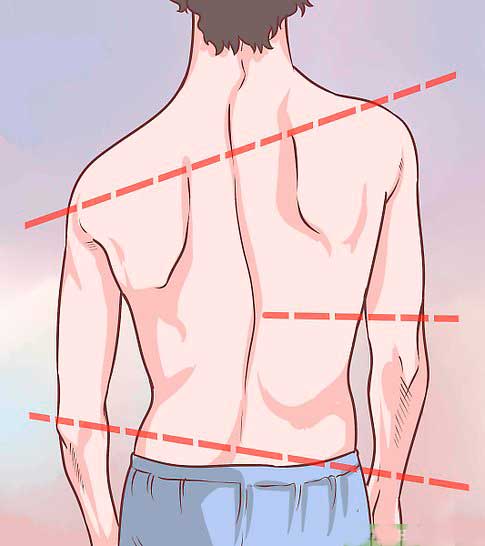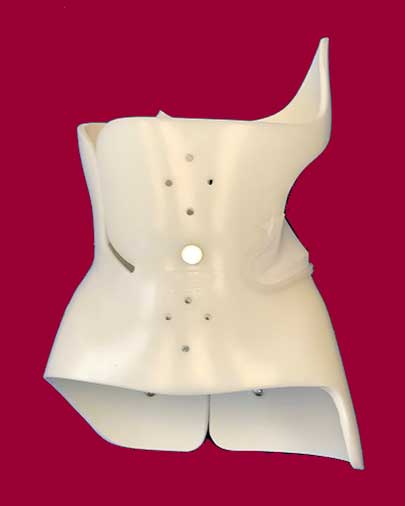
Scoliosis symptoms include uneven shoulders, shoulder blades, ribs, waist, or hips, a noticeable sideways curve in the spine when looking from the back, or the appearance of the ribs being higher on one side when the child is bending over. It is sometimes a friend or family member who initially detects an issue and gets a child to the doctor. Other times, scoliosis is discovered during a school screening. “We consider schools to be the best place to screen for scoliosis so that all children regardless of race, creed, or socio-economic status get an equal opportunity for the least invasive, least expensive and most effective treatment option available,” said Joe O’Brien, president of the National Scoliosis Foundation (NSF). “Fewer than half of U.S. states currently legislate screening for scoliosis in schools, so it is imperative that in addition to school nurses, parents, health professionals, coaches and children are aware of the early signs of scoliosis.” Scoliosis, which tends to run in families, causes the spine to curve sideways in the shape of a “S” or “C” greater than 10 degrees.
Patients must be committed to wearing the brace often or the treatment may not be effective. In scoliosis surgery, vertebrae or bones in the back are fused to together using rods and screws that remain in the back to help straighten the spine and provide stability. Rehabilitation from scoliosis surgery can take several months.
Many major medical associations agree school screenings may be the most important tool in getting pre-teens with scoliosis early treatment. A statement, published in the January 2008 issue of the Journal of Bone and Joint Surgery and endorsed by the American Academy of Orthopaedic Surgeons, the Scoliosis Research Society, the Pediatric Orthopaedic Society of North America and the American Academy of Pediatrics, recommends that girls get scoliosis screenings twice at ages 10 and 12 and boys once at ages 13 or 14.

There is a lot we still don’t know about scoliosis, but what we do know is that it is important to catch the disease early,” said O’Brien. “Scoliosis can develop quickly and we could miss it if we don’t make the time to examine children’s spines.” Advances in scoliosis diagnosis are also rapidly improving. In 2007, researchers announced the discovery of the gene that underlies the scoliosis condition and are working to determine how a defect in this gene affects spinal development. Other researchers are developing the first genetic prognostic test for scoliosis that will use specific genetic markers that predict curve progression. (1)
did you know
• a musculoskeletal disorder in which there is an abnormal curvature of the spine, that may lead to chronic back pain, reduced respiratory function or diminished self-esteem
• the most common deformity of the spine PREVALENCE
• affects one in 40 people in the U.S., or approximately 7 million people
• in 2004, an estimated 1.26 million patients utilized health care resources for problems associated with spinal deformity; 93 percent of those were diagnosed with scoliosis (4)
• the estimated total hospital charges for all patients released from the hospital with a scoliosis diagnosis was $4.6 billion (4)
• each year, an estimated 30,000 children are fitted for a brace and more than 100,000 children and adults diagnosed with scoliosis undergo surgery (5)
• the primary age of onset is between 10-years-old and 15-years-old, but the condition can also affect infants and adults (4)
• girls are eight times more likely than boys to have a curvature that progresses and requires treatment (4)
• scoliosis is more common in families who have scoliosis and increases a person’s risk of having the condition by 20 percent (6)
Reprinted with permission from the National Scoliosis Foundation scoliosis.org
SOURCES (1) National Scoliosis Foundation. Available online: www.scoliosis.org. (2) American Academy of Orthopaedic Surgeons. Available online at: http://orthoinfo.aaos.org/connect/psa.htm. (3) Richards BS and Vitale MG. Screening for Idiopathic Scoliosis in Adolescents:An Information Statement. J Bone Joint Surg Am. 2008; 90:195-198. (4) United States Bone and Joint Decade: The Burden of Musculoskeletal Diseases in the United States. Rosemont, IL:American Academy of Orthopedic Surgeons; 2008. (5) National Scoliosis Foundation.Available online at: www.scoliosis.org. (6) American Academy of Orthopedic Surgeons. Web: http://orthoinfo.aaos.org/topic.cfm?topic=A00236.

